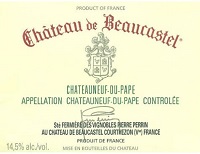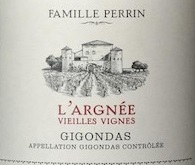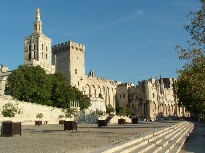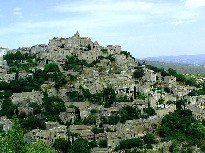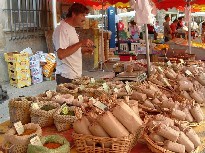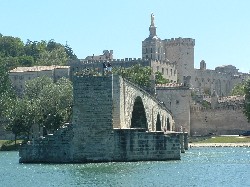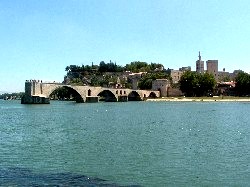The Southern Rhône ValleyThe Southern Rhône is, perhaps, the most beautiful part of France. Coming off the Autoroute de Soleil at Avignon, the traveller is unprepared for the splendour of the region. Taking aright towards Carpentras, one soon encounters the huge Mont Ventoux, seemingly coming out of nowhere, providing a magnificent backdrop to the region’s vineyards. Most of the best vines are located in the Vaucluse department, home to many of France’s “100 most beautiful villages”. Avignon is the region's capital and has several tourist destinations such as the Palais des Papes and the Pont St Bénezet (you know the song) as well as being home, every July, to the Avignon Festival. Wines can sometimes be popular because a region is a great tourist destination. That is certainly true of the Southern Rhône but the region’s increasing popularity may be summed up in three reasons:
Wine lovers who resent the prices of top Bordeaux and Burgundy should look to the Rhône Valley for a wide range of food-friendly wines at remarkable value. As specialists in this region, we list wines from a large number of estates in the Southern Rhône (skip this):
The
Appellations The best known of all the Crus, of course, is Châteauneuf-du-Pape, the birthplace of the appellation system, even more famous for the fact that 13 different varieties may be included in the wines (15 if you count both red and white Grenache and Picpoul). Vines were first planted here by the Knights Templar but it was the arrival of Pope Clement V in Avignon in 1305 during the papal schism that pushed the area towards its modern fame. His successor, Pope John XXII, a wine lover, built a new castle a few miles upstream and encouraged vine-growing in the area (Châteauneuf-du-Pape literally means the Pope’s new castle). Because of the variety of grapes permitted, there is quite a range of wine styles coming out of Châteauneuf-du-Pape. One of the most famous – Château de Beaucastel – is also one of the most controversial as, whereas most wines from the area are based on around 65% Grenache Noir, it uses a high proportion of Mourvèdre (around 35%) in most vintages so the flavours and textures of the wine are quite different. There are around 300 growers, most of which now estate-bottle so most consumers should find something to enjoy. Quality has sky-rocketed over the last twenty years or so, thanks in part to the wine critics, not least Robert M. Parker who has championed the region as a whole. The down-side is that prices have risen too although not in line with Bordeaux and Burgundy. Consumers with deep pockets should certainly look at wines such as Beaucastel. However, under £20 there is an increasing range of seriously good wines that reek of Châteauneuf-du-Pape (although with the current exchange rate this price point could soon be a thing of the past) from producers such as Domaine de Cristia and Raymond Usseglio (both fairly traditional producers), Chateau Capucine (pure Grenache made organically) and Xavier Vignon (a modernist). One off-cited complaint about Châteauneuf-du-Pape is that too many winemakers are sacrificing their best grapes to make expensive prestige bottlings at the expense of the regular wine. This is the inverse of the Bordeaux model where inferior grapes are rejected from the grand vin and put into lesser cuvées. The truth is that there are some superb prestige wines from estates whose house wine is still excellent but that, in these relatively early days, too many are jumping on the bandwagon who shouldn’t. After Châteauneuf-du-Pape comes Gigondas which became an appellation in its own right by decree in 1971. The promotion was resisted by growers in Châteauneuf-du-Pape for historical reasons: Grenache from Châteauneuf had, in the past, been used to beef up the grand crus of Burgundy whilst the same variety from Gigondas had been blended in with mere premiéres crus. The Châteauneuf owners didn’t want to be associated with the riff-raff from across the valley floor, it seems. Perhaps there was another reason: too often, Gigondas wines were as good if not better than those from Châteauneuf-du-Pape. Recently, the gap has widened again, precisely because of the trend towards prestige wines to the detriment of many ‘Tradition ’cuvées. This was a style pioneered in 1986 by Domaine les Goubert whose ‘Cuvée Florence’ is one of the more feminine wines from this most masculine of appellations. Now, one of the most consistently reliable estates for both styles is Domaine Brusset. Other Crus include Lirac where small estates are joined by Châteauneuf-du-Pape producers such as Grand Veneur and Tavel which proudly proclaims itself to be home of the best rosés in France. In the Vaucluse department, Vacqueyras has too often underperformed although it has been getting better; it has recently been joined by Beaumes-de-Venise and Vinsobres. One wonders why these two and not the better villages of Cairanne and Rasteau. The generally accepted answer seems to be that these last two prefer to be top of the heap of the Côtes du Rhône Villages AOC rather than lower down the pecking order of Crus. There are now 19 named villages at this level including the recently promoted Signargues where Christophe Coste's Domaine de la Charité has land and the tiny St-Gervais, home to Domaine Ste-Anne, one of the region's finest estates at any level. The floor of the hierarchy is AOC Côtes du Rhône, the second largest appellation in France after AOC Bordeaux. Surrounding these famous names are the satellite appellations, most famous of which are Costières de Nîmes and Côtes du Ventoux (recently re-named simply Ventoux). This latter appellation, with a few world-class estates such as rising star Chateau Juvenal begins where Gigondas and Beaumes-de-Venise end and travels through the Côtes du Luberon into Peter Mayle country through villages such as Venasque, Gordes and Roussillon, all well worth a detour. All this aside, it is, as always, the producer’s name that is paramount and, aside from the few mentioned above, there are dozens of world class wineries throughout the region. The other major factor, of course, is vintage (see below).
Recent
Vintages 2018: another exceptional
year for Grenache-based wines although problems at the flowering stage reduced
yields by up to 60% in some places such as
Beaucastel. 2016: a fabulous year for Grenache in particular. Wines seem to have brighter acidity than the 2015s and softer tannins, making them easier to appreciate at an early stage but the best should go the distance. Raymond Usseglio's Imperiale is a contender for wine of the vintage but for those of us with less deep pockets, Chateau Juvenal's wines are not to be missed. 2015: Another vintage in which anyone who failed to make good, if not great, wine should give up. What impressed at the early tastings was the return to a more measured style of winemaking, Possibly the recent retirement of Robert Parker gave producers more freedom to pursue styles of wine which were not the blockbusters preferred by the uber-critic. Of course, the best estates in the best terroirs and with the best winemakers were always going to make the most sought after wines but we sought and we scooped them up! 2014: Trickier than most, 2014 is a year which sets winemakers and appellations apart. Outlying areas such as the Ventoux fared better than some of their more prestigious neighbours with (relative) newcomer Chateau Juvenal making a set of truly world class wines with a distinctive Burgundian touch. Other areas, notably Gigondas, produced more austere wines which need time to come round and will never reach the heights of the top years. 2013: Harder tannins than in the previous two vintages meant the wines needed longer cellaring to come round but the structures were sound and the fruit good. 2012: Another top vintage, certainly 4+ stars out of 5, with successes across the board. 2011: Not quite at the level of 2010 but the wines were a little softer, fruitier and more accessible and, for the medium term, a better bet. 2010: Quite superb all round. There is simply no excuse for making bad wine in 2010. 2009: After 2008, any normal vintage was always going to look good but 2009 is right up there with the best of the decade, eclipsed only by 2007 and 2010. Christophe Coste has had a stunning debut vintage for his Chateau Capucine. 2008: the run of great vintages had to end somewhere. 2008 was just too cool so there was little anyone could do to improve things in the vineyards. In the winery, however, was a different story. Some winemakers have pulled out all the stops and, whereas restraint has been necessary in some of the preceding vintages, 2008 was a year of the vigneron. 2007: even better than 2005! Touted as the vintage of the century and we're less than a decade into it. Certainly this is the best vintage I have tasted across the board. Two reasons stand out for me: the long ripening season (fairly cool by recent standards) and the advances of winemaking over, say, 1990. Despite the fall in the value of the pound, this is a vintage to buy into at all levels. Many wines, such as Domaine Brusset's Cairanne "Chabriles" and Gigondas "Le Grand Montmirail" were drinking extremely well as early as 2009 whereas some of the very top wines (Brusset's "Les Hauts de Montmirail" and the Châteauneufs) need time to flesh out. 2006: Yet another wonderful crop of wines. Raymond Usseglio and Domaine de Cristia both made superb classic Châteauneuf-du-Pape. Beaucastel has turned a corner with a fresher wine than usual. 2005: The perfect year? For many the answer has to be a resounding "YES" although watch those rising alcohol levels (and wait for 2007!). 2004: Another vintage where it was difficult to see how anyone who knows how to make wine could go wrong. Some did, inevitably, but it is a vintage where consumers can buy with confidence. Raymond Usseglio and Domaine de Cristia were both very successful in Châteauneuf-du-Pape. 2003: The heatwave caused vines to shut down for much of the summer and resulted in a harvest around four weeks earlier than usual. Some producers panicked and have made wines which have unripe tannins. The better estates, however, produced some prodigious wines which will drink well at a relatively young age ( for example, we drank most of our Gigondas etc at around 5-6 years and will not leave the Châteauneuf much longer than that). 2002: Floods just prior to the harvest destroyed much of the crop and diluted most of the rest so caveat emptor. Some good wines were made, particularly in hillside locations (such as the Brusset's Les Hauts de Montmirail) but many producers in Châteauneuf-du-Pape didn't produce any wine at all in 2002. 2001: Four great vintages in a row seemed too much to ask for but this region managed it. 2001 produced a small crop of intensely flavoured, structured wines but with low acidity, a hallmark of good vintages here, means another must-buy vintage. 2000: Whilst every wine region hoped for a fabulous crop to celebrate the Millenium, the Southern Rhône made it three in a row with the 2000 vintage looking like it could be the best since 1978. The top reds have massive fruit masking their excellent tannic structures. 1999: Another fabulous vintage, a rival for 1998 (our recent tastings have confirmed that many estates produced better wines in 1999 than in 1998, particularly in Gigondas, Vacqueyras and the villages). Wines had softer, sweeter tannins than their older siblings, making them more accessible, but it is their fruit which makes this vintage so good. Full, rich and sweet black fruit characters are the hallmarks of the best 1999s. 1998: Expected to be the outstanding vintage of the decade in the Southern Rhône (the best since 1990, if not 1978). None of the other major wine-producing regions of France (also the rest of Europe and virtually everywhere else, thanks to El Niño) achieved such consistently good results in 1998. 1997: After April frosts and a damp start to the summer, producers were relieved when it warmed up in August and continued to remain dry throughout the harvest. Some good to very good wines were produced although this is a caveat emptor vintage. Most wines were easy drinking offering which repaid early drinking and should have been drunk up by now. 1996: A decent vintage. The warm, dry summer produced a very ripe crop which required minimal human intervention. relatively high acidity levels meant these were not the most attractive wines on release but they should age gracefully. The better wines are beginning to drink well towards 2010. 1995: The best year since 1990 produced rich, concentrated wines, many of which will develop well for at least a decade. Especially good in Gigondas and Châteauneuf. 1994: Good to very good generally. In Châteauneuf-du-Pape vignerons produced their best wines of the decade so far, some almost on a par with the 1995s. Forward in style, most of the best wines are drinking very well now (or should have been drunk up in many cases). 1993: The best vintage since 1990 (although that doesn't count for much) produced wines which are solid and robust, needing up to ten years’ ageing. Fairly classic but not the most exciting wines. 1992: Generally disastrous throughout France and, with the notable exception of Châteauneuf-du-Pape, the Rhône was no different. Of course, there will always be wines that buck the trend. 1991: A few decent wines were made in this extremely mediocre vintage. These should have been drunk up by now; if not, they have probably lost their fruit and dried out. 1990: A great, powerful vintage with wines showing plenty of fruit, alcohol and tannin. The top wines have amazing longevity; many of them still are not fully mature. |
|||||||||||
|
You must be aged 18 or over to purchase wine. |




